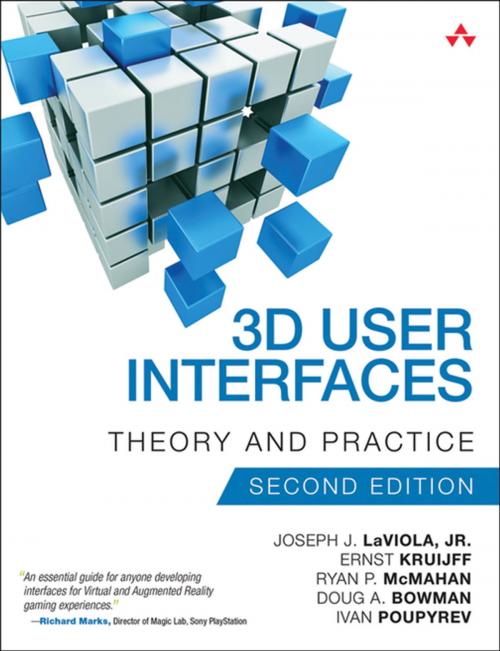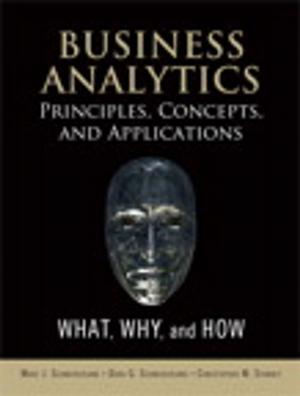3D User Interfaces
Theory and Practice
Nonfiction, Computers, Advanced Computing, Programming, User Interfaces, Software Development| Author: | Joseph J. LaViola Jr., Ernst Kruijff, Ryan P. McMahan, Doug Bowman, Ivan P. Poupyrev | ISBN: | 9780134034461 |
| Publisher: | Pearson Education | Publication: | April 7, 2017 |
| Imprint: | Addison-Wesley Professional | Language: | English |
| Author: | Joseph J. LaViola Jr., Ernst Kruijff, Ryan P. McMahan, Doug Bowman, Ivan P. Poupyrev |
| ISBN: | 9780134034461 |
| Publisher: | Pearson Education |
| Publication: | April 7, 2017 |
| Imprint: | Addison-Wesley Professional |
| Language: | English |
The Complete, Up-To-Date Guide to Building Great 3D User Interfaces for Any Application
3D interaction is suddenly everywhere. But simply using 3D input or displays isn’t enough: 3D interfaces must be carefully designed for optimal user experience. 3D User Interfaces: Theory and Practice, Second Edition is today’s most comprehensive primary reference to building state-of-the-art 3D user interfaces and interactions. Five pioneering researchers and practitioners cover the full spectrum of emerging applications, techniques, and best practices. The authors combine theoretical foundations, analysis of leading devices, and empirically validated design guidelines. This edition adds two new chapters on human factors and general human-computer interaction—indispensable foundational knowledge for building any 3D user interface. It also demonstrates advanced concepts at work through two running case studies: a first-person VR game and a mobile augmented reality application.
Coverage Includes
- 3D user interfaces: evolution, elements, and roadmaps
- Key applications: virtual and augmented reality (VR, AR), mobile/wearable devices
- What 3D UI designers should know about human sensory systems and cognition ergonomics
- How proven human-computer interaction techniques apply to 3D UIs
- 3D UI output hardware for visual, auditory, and haptic/ tactile systems
- Obtaining 3D position, orientation, and motion data for users in physical space
- 3D object selection and manipulation
- Navigation and wayfinding techniques for moving through virtual and physical spaces
- Changing application state with system control techniques, issuing commands, and enabling other forms of user input
- Strategies for choosing, developing, and evaluating 3D user interfaces
- Utilizing 2D, “magic,” “natural,” multimodal, and two-handed interaction
- The future of 3D user interfaces: open research problems and emerging technologies
The Complete, Up-To-Date Guide to Building Great 3D User Interfaces for Any Application
3D interaction is suddenly everywhere. But simply using 3D input or displays isn’t enough: 3D interfaces must be carefully designed for optimal user experience. 3D User Interfaces: Theory and Practice, Second Edition is today’s most comprehensive primary reference to building state-of-the-art 3D user interfaces and interactions. Five pioneering researchers and practitioners cover the full spectrum of emerging applications, techniques, and best practices. The authors combine theoretical foundations, analysis of leading devices, and empirically validated design guidelines. This edition adds two new chapters on human factors and general human-computer interaction—indispensable foundational knowledge for building any 3D user interface. It also demonstrates advanced concepts at work through two running case studies: a first-person VR game and a mobile augmented reality application.
Coverage Includes
- 3D user interfaces: evolution, elements, and roadmaps
- Key applications: virtual and augmented reality (VR, AR), mobile/wearable devices
- What 3D UI designers should know about human sensory systems and cognition ergonomics
- How proven human-computer interaction techniques apply to 3D UIs
- 3D UI output hardware for visual, auditory, and haptic/ tactile systems
- Obtaining 3D position, orientation, and motion data for users in physical space
- 3D object selection and manipulation
- Navigation and wayfinding techniques for moving through virtual and physical spaces
- Changing application state with system control techniques, issuing commands, and enabling other forms of user input
- Strategies for choosing, developing, and evaluating 3D user interfaces
- Utilizing 2D, “magic,” “natural,” multimodal, and two-handed interaction
- The future of 3D user interfaces: open research problems and emerging technologies















